Logistics Technology That’s Changing the Game
If you’ve ever waited for an online order, you already know how much tech matters in getting that box to your door. Today, logistics companies rely on a handful of smart tools to move inventory faster, cut errors, and keep costs low. Let’s break down the tech that’s turning traditional warehouses into high‑speed hubs.
Core Systems: WMS and TMS
A Warehouse Management System (WMS) is the brain behind every pallet, shelf, and picker route. Instead of guessing where stock lives, a WMS tells you the exact location, the best pick path, and when to restock. The result? Less time wandering aisles and more orders shipped on time. Our own guide on What Does WMS Mean? walks you through choosing the right system, comparing costs, and spotting the features that matter most.
Transportation Management Software (TMS) does the same for the road. It matches loads to the cheapest carrier, plots optimal routes, and even predicts delays from traffic or weather. When you combine a solid WMS with a TMS, the whole supply chain talks to itself, reducing manual hand‑offs and freeing staff to focus on customer service.
Emerging Tech: AI, IoT, and Automation
Artificial Intelligence is no longer a buzzword—it's a daily assistant. AI can forecast demand spikes, adjust inventory levels, and flag potential stock‑outs before they happen. Pair AI with Internet of Things (IoT) sensors on pallets and you get real‑time temperature, humidity, and location data. That’s how perishable goods stay fresh from factory to fridge.
Automation adds the muscle. Robots pick and pack, conveyor belts sort parcels, and drones scout large yards for misplaced items. Even small businesses can tap into automation with modular solutions that plug into existing WMS platforms. The payoff is quicker order processing and fewer human errors.
All these tech pieces work together to make the supply chain more visible. When you can see every step—warehouse receipt, transport leg, last‑mile drop—you can troubleshoot instantly. That visibility is why customers now expect same‑day or next‑day delivery, and why logistics firms that invest in technology stay ahead.
At StockOne Logistics, we blend these tools into a single, seamless service. Whether you need a scalable WMS for a growing e‑commerce store or a smart TMS to handle cross‑border freight, our team configures the right stack for your business. The result is faster deliveries, lower costs, and happier customers.
Ready to upgrade your logistics game? Start by mapping out where you lose time or money—maybe it’s manual data entry or poor route planning. Then pick a technology that solves that specific pain point. Remember, you don’t need every gadget at once; a solid WMS or TMS can deliver immediate ROI, and you can layer AI, IoT, and automation as you grow.
Bottom line: modern logistics technology isn’t just for giants. With the right mix of software and smart devices, any business can run a tighter, faster, and more reliable supply chain. Explore our articles, pick the tools that fit, and watch your operations transform.
Essential Logistics Software: Tools That Power Modern Supply Chains
Explore essential logistics software types, real-world examples, and tips for choosing the right tools to boost efficiency and accuracy in supply chains.
Read MorePepsiCo's Warehouse Management System Uncovered: A Deep Dive into Their Technology
PepsiCo is a global leader in the food and beverage industry, and efficient warehouse management plays a key role in their success. By utilizing advanced Warehouse Management Systems (WMS), PepsiCo ensures streamlined operations from production to delivery. This article delves into what WMS choice aids their logistics, enhancing efficiency and customer satisfaction. It also provides insights and tips on the benefits of specific WMS features.
Read More
